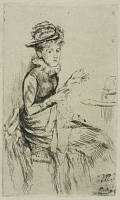Freetext search terms: mast
Tatting | ||
| Number: | 130 | |
| Date: | 1874 | |
| Medium: | etching | |
| Size: | 126 x 74 mm | |
| Signed: | no | |
| Inscribed: | no | |
| Set/Publication: | Fine Art Society | |
| No. of States: | 1 | |
| Known impressions: | 10 | |
| Catalogues: | K.112; M.111; W.98 | |
| Impressions taken from this plate (10) | ||
KEYWORD
TITLE
'TATTING' (1880, Dowdeswell's). 6
Possibly 'Miss Dawson Sitting' (1877, Whistler). 7
The title, 'Miss Dawson Sitting', suggests the woman is Elizabeth Dawson (b. 1840). However, it is not the only etching of an unidentified seated figure at this period (see also Reading a Book [112] and The Muff [131]).
8: Mansfield 1909 (cat. no. 111); see also Isabella Mary Beeton, Beeton's Book of Needlework, Ward, Lock and Tyler, 1870.
DESCRIPTION
SITTER
According to Frederick Wedmore, 'This and the preceding plate Mr Whistler told me he believed were studies from the Leylands.' 9
Whistler drew and etched several women of the Leyland family, including Frances Leyland (1834-1910), and Elizabeth Dawson. The latter is probably the model for The Silk Dress [151], and for portrait drawings such as r.: Elizabeth Dawson in profile; v.: A nude leaning against a rail [m0440], Elizabeth Dawson, full face [m0441], Head of a woman [m0442] and r.: Self-portrait; v.: standing woman [m0463].
9: Wedmore 1886 A (cat. no. 98).
10: See Whistler to F. D. Leyland, [September 1873?], GUW #08055; Rossetti 1977 , p. 166; Merrill 1998 , pp. 133-37, p. 364, n. 140-41.
11: C. A. Howell to Whistler, 6-15 November 1877, GUW #02178.
12: Lochnan 1984 , p. 165.
DISCUSSION
14: Lochnan 1984 , p. 165.
